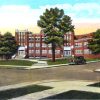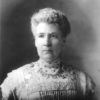calsfoundation@cals.org
Magnolia Colored School District
The buildings of the Magnolia Colored School served the African American population of Magnolia (Columbia County) between 1915 and 1969. The Magnolia Colored School Historic District—which makes up a city block bounded by Madison, School, and Ross streets on the southwest side of town and included four buildings built between 1940 and 1965—was added to the National Register of Historic Places on January 22, 2014.
The original school for Black students was north of Bethlehem Baptist Church on Ross Street across from the Magnolia City Cemetery and behind the later location of Arnold-Baker Chevrolet. It was near what would eventually become Columbia High School, located at 611 S. Madison Street in Magnolia.
Beginning in 1915, Columbia County’s Black students were provided a formal education at one of two schools in Magnolia. The first was the Magnolia Colored School, while the second school, Columbia Baptist Academy, was established in 1919 through the Julius Rosenwald Fund, which helped finance the construction of schools for Black students across the South. Unlike the first, the private Columbia Baptist Academy required that parents pay tuition for their children to attend.
In 1915, the Magnolia Colored School consisted of a two-story wood-framed building. The first floor consisted of a foyer, a broom room, and two classrooms for grades one through six. The second floor was one large room that housed seventh and eighth graders and was also used as the auditorium. From 1915 to 1939, only first through eighth grades were taught at Magnolia Colored School.
As the Black population in Columbia County continued to grow from 1930 through the 1940s, there arose a need to construct new schools. By 1939, the two-story brick Magnolia Colored School building was constructed, which housed first through twelfth grades. In 1939, Black students outnumbered white students in Columbia County 3,811 to 3,638.
Along with this new Magnolia Colored School built in 1939–40, another school was constructed in the Walker School District, which was the combination of Burton, West Grammar, Wilbourn, and Mount Calm School Districts through consolidation.
The Magnolia Colored School would only last a little more than eight years because on January 26, 1948, the two-story school building was destroyed by fire. The volunteer firefighters were hampered by frigid weather and ice that coated the water connections. With the building completely engulfed in flames, the fire department turned their attention on preventing the spread of flames to the home economics building and manual training shop. It was originally believed that the fire started on the south side of the main building’s second floor, but there had been no power to the building for several days prior to the fire because of ice and snow accumulation. There was no explanation of how the fire started. The school district immediately sought alternate locations to conduct classes and began looking for replacement textbooks.
The students were back to school by Tuesday of the following week, resuming their classes in four Black churches in the city and in the two smaller buildings that were not burned in the fire. The shop building was constructed in 1940 of brick, while the home economics building was originally constructed with weatherboard. While these buildings continued to be used, all high school classes were moved to the Bethlehem Baptist and Trinity Christian Methodist Episcopal (CME) churches, and most grammar school classes were taught at Mount Tabor Baptist and St. Phillips African Methodist Episcopal (AME) churches. All fourth-grade students met on campus in the home economics building, while all students studying agriculture continued to meet in the school’s manual shop building. Administration for the school was conducted from the Bethlehem Baptist Church pastor’s study.
Using the church spaces as classrooms following the fire, a record enrollment of 815 students began the second semester. The problem of the long distance students had to travel between class periods in going from one church to another was quickly solved by delaying the start of the next class. There was also a lack of sufficient restrooms for the number of students in each church (and of the remaining two buildings on campus, only one had a restroom). It was noted that the school was working on constructing “outdoor toilets” on the campus. The only textbooks that were available were those that students had taken home before the night of the fire or those supplied by the Arkansas Department of Education.
The school hired the architectural firm of Trapp and Clippard of El Dorado (Union County) and Little Rock (Pulaski County), and design plans were created by April 19, 1948. The plans stated that they would construct two one-story buildings, one to house the high school and another to house the grammar school. It was built on the foundation of the old structure in order to cut construction costs. The district also purchased surplus building materials from Camp Joseph T. Robinson Maneuver Training Center, the Arkansas Army National Guard installation located in North Little Rock (Pulaski County).
The school was ready to open its doors on September 13, 1948. The new campus included a high school, a grade school, a home economics cottage, a vocational agriculture shop, a lunchroom, and a gymnasium/auditorium. (Only the home economics cottage and the vocational agriculture shop were buildings that had survived the fire.) The newly constructed grade school contained five classrooms and was the same design as the high school building. When the schools were completed, Principal F. B. Buffington stated that the high school building would be “the most modern high school for Negroes in the state.”
In September 1950, the Magnolia Colored School’s name was changed to Columbia County High School. After 1954, it became simply Columbia High School. The school was merged with the Magnolia Public School District through the U.S. Federal Civil Rights Act of 1964, but complete integration throughout the district was not complete until 1970 in Columbia County. As a consequence, Columbia High School was closed in 1969.
The high school building still stands in the twenty-first century, but the property is unused. The predominantly Black Walker School District No. 33, located south of Magnolia, was also headquartered in Columbia County and operated as the Walker School, but it was consolidated with the Magnolia Public School District on July 1, 2004. It began serving as the Pre-K Center for the entire county.
For additional information:
“Magnolia Colored School Historic District.” National Register of Historic Places registration form. On file at Arkansas Historic Preservation Program. Online at https://www.arkansasheritage.com/arkansas-historic-preservation-program (accessed August 2, 2025).
“Magnolia Colored School Historic District Receives National Recognition.” Magnolia Reporter, February 10, 2014, updated April 23, 2015. https://www.magnoliareporter.com/news_and_business/local_news/article_d9a723f2-92be-11e3-bcef-0019bb2963f4.html (accessed August 2, 2025).
Amy Staten McNeil
South Arkansas Heritage Museum
 Education, Elementary and Secondary
Education, Elementary and Secondary Historic Preservation
Historic Preservation Columbia Baptist Academy
Columbia Baptist Academy  Columbia High School
Columbia High School  Magnolia Colored School
Magnolia Colored School  Youngblood Christian Center
Youngblood Christian Center 



Comments
No comments on this entry yet.